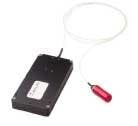Carriers eye tunable lasers and ROADMs
British Telecom (BT—London) recently announced its decision to migrate its multiple existing networks to a single converged multiservice IP-based network, dubbed the 21st Century Network. AT&T (Bedminster, NJ) is moving ahead with a similar plan, called "Concept of One," to collapse its service-specific networks into one MPLS-based optical backbone. The carrier is also implementing what it calls the "Concept of Zero" philosophy, which aims for zero defects while providing services without any human intervention through a fully automated process. MCI (Ashburn, VA), meanwhile, is currently deploying an ultra-long-haul DWDM network that will serve as the foundation upon which all the carrier's services will be delivered.
Such network convergence and full automation requires more sophisticated equipment, a notion reflected in recent carrier RFPs that specify widely tunable lasers and reconfigurable optical add/drop multiplexers (ROADMs). Are carriers finally ready to tap into the promises of wideband tunability and reconfigurability?
While it's easy to wax poetic about the promise of tunable lasers for service-related functions, the carriers caution against diminishing the economic advantages of tunable lasers used in sparing applications. "That's a real cost to us and a real cost to our suppliers," contends Jack Wimmer, vice president of network architecture and advanced technology at MCI. "The idea that I can carry one or two spares in a location rather than 160 spares is very significant. That is our first application for tunable lasers."
According to Phil Wisseman, lead member of the technical staff at SBC Labs (Austin, TX), most of the DWDM systems that SBC is eyeing include tunable lasers. He does not envision widespread deployment of DWDM without tunable lasers, simply because of the cost related to sparing with fixed lasers.AT&T has likewise embraced tunable lasers for sparing purposes as well as for set-and-forget applications, in which the laser is tuned only once as the system is installed. AT&T has deployed Siemens's SURPASS hiT 7500 system, complete with intelligent optical switches and transponders that are tunable over 80 channels. "We believe [tunable lasers] will help with inventory by allowing us to treat a transponder like a SONET pack," explains an AT&T spokesperson via email. "We can deploy any transponder in any system on any wavelength without worrying about the wavelength usage or provisioning." Tunable lasers enable faster provisioning, says the carrier, because there is no need to custom-order devices for individual wavelengths.
There are two flavors of tunable lasers: narrowly tunable, which tune over a few hundred gigahertz, and widely tunable, which can tune over the entire C-band. While narrowly tunable lasers are sufficient for sparing and set-and-forget applications, "the interesting thing we've found over the past few months is that carriers are really interested in full C-band tunability," reports Sterling Perrin, senior analyst, optical networking, at market analyst IDC (Framingham, MA). "This leads me to think that the initial draw of tunable lasers—reconfigurability or the ability to dynamically tune a wavelength—is definitely on the carriers' minds. They are not there yet with reconfigurability, but it seems to be on their roadmap. They are always interested in futureproofing their deployments as much as possible."
Over the past six months or so, several vendors have announced that they are incorporating widely tunable lasers into their systems, "and this at least allows carriers to make a choice between tunable or not," says Perrin.
Of course, just because carriers are asking for widely tunable lasers doesn't mean they will deploy them for service-oriented applications in the near-term. "We're going to see tunable lasers used for sparing and set-and-forget, which is an actual in-network application," notes Perrin. "Set-and-forget means it's actually running in the system. So we're going to see that first. The carriers will get used to them, and then over time we'll see more interesting applications emerge."
If the recent SuperComm conference is any indication, today's carriers seem just as interested in reconfigurability as they are in tunability. The great promise of an ROADM is its ability to provide any-to-any connectivity and single-wavelength granularity of add/drop without engineering involvement. It simplifies the network by removing jumper cables from the provisioning process, saving carriers from having to dispatch engineers and equipment to the field for manual provisioning.
A number of system vendors unveiled ROADM functionality at SuperComm in June, including Fujitsu Network Communications (Richardson, TX), which launched an extension to its Flashwave 7500 to provide ROADM functionality with the in-service addition of a single shelf. Nortel Networks (Ottawa, Ontario) introduced its Common Photonic Layer platform, and Cisco Systems (San Jose, CA) demonstrated Release 4.7 of its ONS 15454 multiservice transport platform, which now features ROADM-like functionality. Lucent Technologies (Murray Hill, NJ), meanwhile, showcased its Metropolis wavelength services manager (WSM), jointly developed by Movaz Networks (Atlanta), which unveiled RAYROADM. And Meriton Networks (Ottawa, Ontario) announced a ROADM interface for its OADX 7200.
For their part, the carriers seem serious about reconfigurability. SBC has just finished an RFP process and is now conducting lab evaluations, reports Wisseman. The carrier is targeting the end of this year or early next year for deployment. SBC is interested in ROADMs to reduce pre-planning requirements, he says. "We are looking to deploy DWDM rings where you can treat wavelengths as an equivalent to STS-1s in SONET, so that you can drop any wavelength at any location and not have to pre-plan traffic patterns," he explains.AT&T is also deploying ROADMs "and has been for some time," says a spokesperson for the carrier. "We believe both tunability and reconfigurability have value. Tunable transmitters address immediate inventory/sparing needs and reduce our wavelength provisioning time. ROADMs will give us flexibility and drive cycle time down even further. Full tunability—both add and drop—and the ability to optically express at any node and regenerate only as needed will provide the final step to deliver wavelengths on demand."
That final step might not be taken overnight, however. MCI's Wimmer reports his company is also "aggressively looking for reconfigurable OADMs in both the metro and long-haul so [it] can automate the provisioning process even further."
That said, he makes a distinction between the use of ROADMs for wavelength provisioning and the use of ROADMs for real time restoration. "The ability to provision a wavelength doesn't require a great deal of speed, and in truth, once I provision a wavelength through an OADM, it tends to stay provisioned for a long period of time," he explains. "But reconfigurability in real time is really driven by restoration, which requires high-speed—read: tunable—lasers." While that is the long-term goal, widely tunable lasers are not yet fast enough to support a real time restoration environment, says Wimmer.
The fact that carriers now have several choices in terms of ROADM vendors may stall deployments even more, says IDC's Perrin. The big players used to be startups like Movaz Networks, Tropic Networks (Ottawa, Ontario), and Photuris, recently acquired by Mahi Networks (Petaluma, CA).
Carriers, particularly the RBOCs, have been reluctant to deal with startups in the past, but now that the incumbents have begun offering ROADM functionality, "their timeline is probably more in sync with what the carriers will do," asserts Perrin. "My sense is that some of the RFPs that are out there will be postponed so the RBOCs can get a look at the big vendors and what they have for technology. It's not that urgent a need where they would need to take a risk with a smaller supplier to get this technology."


